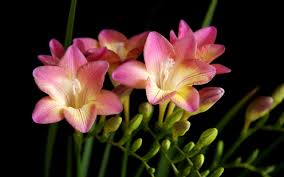Freesia
Freesia
Freesia is a genus of around 16 species of flowering plants in the family Iridaceae, native to the eastern side of southern Africa, from Kenya down to South Africa, most species being found in Cape Province.[citation needed] Species of the former genus Anomatheca are now included in Freesia. The plants commonly known as "freesias", with fragrant funnel-shaped flowers, are cultivated hybrids of a number of Freesia species. Some other species are also grown as ornamental plants.
They are herbaceous plants which grow from a corm 1–2.5 cm diameter, which sends up a tuft of narrow leaves 10–30 cm long, and a sparsely branched stem 10–40 cm tall bearing a few leaves and a loose one-sided spike of flowers with six tepals. Many species have fragrant narrowly funnel-shaped flowers, although those formerly placed in the genus Anomatheca, such as F. laxa, have flat flowers.
Freesias are used as food plants by the larvae of some Lepidoptera species including Large Yellow Underwing.
The World Checklist of Selected Plant Families lists 16 species as of August 2012.
Freesia alba (G.L.Mey.) Gumbl. (syn. F. gentilis N.E.Br., F. herbertii N.E.Br., F. picta N.E.Br.)
Freesia andersoniae L.Bolus
Freesia caryophyllacea (Burm.f.) N.E.Br. (syn. F. elimensis L.Bolus, F. parva N.E.Br., F. xanthospila (DC.) Klatt)
Freesia corymbosa (Burm.f.) N.E.Br. (syn. F. armstrongii W.Watson, F. brevis N.E.Br.)
Freesia fergusoniae L.Bolus
Freesia fucata J.C.Manning & Goldblatt
Freesia grandiflora (Baker) Klatt
Freesia laxa (Thunb.) Goldblatt & J.C.Manning (syn. F. cruenta (Lindl.) Klatt)
Freesia leichtlinii Klatt (syn. F. middlemostii F.Barker, F. muirii N.E.Br.)
Freesia marginata J.C.Manning & Goldblatt
Freesia occidentalis L.Bolus (syn. F. framesii L.Bolus)
Freesia refracta (Jacq.) Klatt (syn. F. hurlingii L.Bolus)
Freesia sparrmanii (Thunb.) N.E.Br.
Freesia speciosa L.Bolus (syn. F. flava (E.Phillips & N.E.Br.) N.E.Br.)
Freesia verrucosa (B.Vogel) Goldblatt & J.C.Manning (syn. F. juncea (Pourr.) Klatt)
Freesia viridis (Aiton) Goldblatt & J.C.Manning
Species of the former genus Anomatheca are now included in Freesia:
Anomatheca cruenta Lindl. = Freesia laxa subsp. laxa
Anomatheca grandiflora Baker = Freesia grandiflora
Anomatheca juncea (Pourr.) Ker Gawl. = Freesia verrucosa
Anomatheca laxa (Thunb.) Goldblatt = Freesia laxa
Anomatheca verrucosa (B.Vogel) Goldblatt = Freesia verrucosa
Anomatheca viridis (Aiton) Goldblatt = Freesia viridis
Anomatheca xanthospila (DC.) Ker Gawl. = Freesia caryophyllacea






Cultivation and uses
The plants usually called "freesias" are derived from crosses made in the 19th century between F. refracta and F. leichtlinii. Numerous cultivars have been bred from these species and the pink- and yellow-flowered forms of F. corymbosa. Modern tetraploid cultivars have flowers ranging from white to yellow, pink, red and blue-mauve. They are widely cultivated and readily increased from seed. Due to their specific and pleasing scent, they are often used in hand creams, shampoos, candles, etc.[citation needed]
They can be planted in the fall in USDA Hardiness Zones 9-10 (i.e. where the temperature does not fall below about −7 °C (20 °F)), and in the spring in Zones 4-8.
F. laxa (formerly called Lapeirousia laxa or Anomatheca cruenta) is one of the other species of the genus which is commonly cultivated. Smaller than the scented freesia cultivars, it has flat rather than cup-shaped flowers.
Extensive 'forcing' of this bulb occurs in Half Moon Bay California where several growers chill the bulbs in proprietary methods to satisfy cold dormancy which results in formation of buds within a predicted number of weeks – often 5 weeks at 55°F.



Kingdom: Plantae
(unranked): Angiosperms
(unranked): Monocots
Order: Asparagales
Family: Iridaceae
Subfamily: Ixioideae
Genus: Freesia











No comments:
Post a Comment